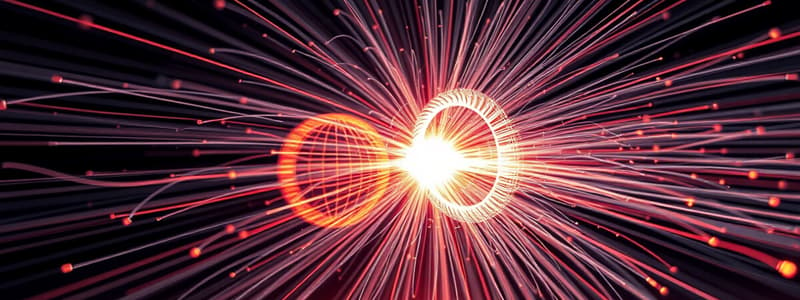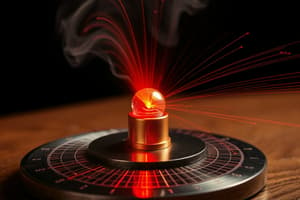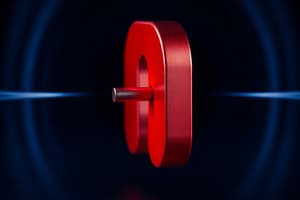Podcast
Questions and Answers
What determines the Magnetic Field Strength of a coil?
What determines the Magnetic Field Strength of a coil?
- The type of wire used
- The temperature of the environment
- The ampere turns of the coil (correct)
- The length of the coil
What is Electromagnetic Induction?
What is Electromagnetic Induction?
- The generation of electric current from magnetic movement (correct)
- The process of storing electrical energy
- A process that generates heat from electricity
- A method of increasing magnetic field strength
What was the key discovery made by Michael Faraday?
What was the key discovery made by Michael Faraday?
- The strength of a wire increases with higher temperatures
- Electricity can be generated from heat
- Batteries are unnecessary for electrical circuits
- Magnetic fields can induce an electrical current (correct)
What happens to the galvanometer needle when the magnet is moved towards the coil?
What happens to the galvanometer needle when the magnet is moved towards the coil?
What occurs when the magnet is held stationary with respect to the coil?
What occurs when the magnet is held stationary with respect to the coil?
How can current be induced in a coil without using a battery?
How can current be induced in a coil without using a battery?
What does Faraday’s Law of Electromagnetic Induction relate to?
What does Faraday’s Law of Electromagnetic Induction relate to?
If the coil is moved away from a stationary magnet, what will happen to the galvanometer needle?
If the coil is moved away from a stationary magnet, what will happen to the galvanometer needle?
What is the expression for total reluctance in a series magnetic circuit?
What is the expression for total reluctance in a series magnetic circuit?
How is total mmf calculated in a magnetic circuit?
How is total mmf calculated in a magnetic circuit?
In parallel magnetic circuits, how is the ampere turns (mmf) for the circuit determined?
In parallel magnetic circuits, how is the ampere turns (mmf) for the circuit determined?
Which of the following correctly defines the reluctance of a path in a magnetic circuit?
Which of the following correctly defines the reluctance of a path in a magnetic circuit?
What is the relationship between the magnetic flux and magnetic field strength in a magnetic circuit?
What is the relationship between the magnetic flux and magnetic field strength in a magnetic circuit?
Which of the following correctly relates magnetic flux to reluctance and mmf?
Which of the following correctly relates magnetic flux to reluctance and mmf?
What does the symbol µ0 represent in magnetic circuit expressions?
What does the symbol µ0 represent in magnetic circuit expressions?
Which analogy is correctly matched between magnetic and electric circuits?
Which analogy is correctly matched between magnetic and electric circuits?
What is the formula for calculating magnetic field intensity H?
What is the formula for calculating magnetic field intensity H?
What is the relationship between magnetic flux density B and magnetic field intensity H?
What is the relationship between magnetic flux density B and magnetic field intensity H?
In a magnetic circuit, what is the primary effect of using different materials?
In a magnetic circuit, what is the primary effect of using different materials?
How is reluctance calculated in a magnetic circuit containing air gaps?
How is reluctance calculated in a magnetic circuit containing air gaps?
What is the current required to produce a flux of 800 mWb in a ring made of mild steel with permeability about 380?
What is the current required to produce a flux of 800 mWb in a ring made of mild steel with permeability about 380?
What is the effect of increasing the number of turns N in a coil on the magnetic field intensity H?
What is the effect of increasing the number of turns N in a coil on the magnetic field intensity H?
If the cross-sectional area A of a magnetic circuit is increased, what happens to the magnetic flux density B?
If the cross-sectional area A of a magnetic circuit is increased, what happens to the magnetic flux density B?
What is the reluctance of a mild steel ring with a cross-sectional area of 500 m² and mean circumference of 400 mm?
What is the reluctance of a mild steel ring with a cross-sectional area of 500 m² and mean circumference of 400 mm?
What does Lenz's Law state about the direction of induced emf?
What does Lenz's Law state about the direction of induced emf?
What is the term used for the emf that opposes the change causing it?
What is the term used for the emf that opposes the change causing it?
Which statement is true concerning the relationship between changing magnetic flux and induced current?
Which statement is true concerning the relationship between changing magnetic flux and induced current?
What happens when the magnetic flux decreases according to Lenz’s law?
What happens when the magnetic flux decreases according to Lenz’s law?
What occurs due to the induced emf within a metallic part not connected to the electrical circuit?
What occurs due to the induced emf within a metallic part not connected to the electrical circuit?
What does Lenz's law relate to regarding energy?
What does Lenz's law relate to regarding energy?
Which conclusion can be drawn about self-induced emf as the rate of current change increases?
Which conclusion can be drawn about self-induced emf as the rate of current change increases?
How is the term 'induced emf' characterized in the context of electromagnetic induction?
How is the term 'induced emf' characterized in the context of electromagnetic induction?
What do eddy currents do in a magnetic circuit?
What do eddy currents do in a magnetic circuit?
Which law states that the induced current will always oppose the change in magnetic flux?
Which law states that the induced current will always oppose the change in magnetic flux?
What is the primary purpose of eddy currents in electromagnetic induction furnaces?
What is the primary purpose of eddy currents in electromagnetic induction furnaces?
What happens to eddy currents in terms of useful energy transfer in a magnetic circuit?
What happens to eddy currents in terms of useful energy transfer in a magnetic circuit?
In a composite magnetic circuit, what contributes to the total magnetomotive force (MMF)?
In a composite magnetic circuit, what contributes to the total magnetomotive force (MMF)?
Which term in magnetic circuits corresponds to the current in electrical circuits?
Which term in magnetic circuits corresponds to the current in electrical circuits?
What is the relationship between reluctance and magnetic flux in a magnetic circuit?
What is the relationship between reluctance and magnetic flux in a magnetic circuit?
What does the expression for energy storage in a magnetic field depend on?
What does the expression for energy storage in a magnetic field depend on?
Flashcards are hidden until you start studying
Study Notes
Magnetic Field and Flux Relationships
- Magnetic field intensity (H) is calculated by the formula: ( H = \frac{NI}{L} ) (ampere-turns/meter).
- Magnetic flux density (B) is related to magnetic field intensity through the equation: ( B = \mu H ).
Problem-Solving with Magnetic Materials
- A copper core's susceptibility is given as (-9.7 \times 10).
- For core length (L), gap length (g), cross-sectional area (A), current (I), and number of turns (N), magnetic properties can be derived.
Calculating Magnetic Properties
- For a coil with 200 turns wound on a wooden ring:
- Magnetic field strength: 1333 A/m.
- Flux density: ( 1.675 \times 10^{-3} , \text{T} ).
- Total flux: 0.8375 mWb.
Mild Steel Ring Analysis
- A mild steel ring with a cross-sectional area of 500 m(^2) and mean circumference of 400 mm:
- Reluctance of the ring calculated as ( 1.677 \times 10^6 , \text{A/Wb} ).
- Current needed to produce a flux of 800 mWb is found to be 6.7 A.
Series Magnetic Circuits
- Series magnetic circuits consist of different materials, creating multiple paths for flux.
- Total reluctance (S) is the sum of individual reluctances: ( S = S_1 + S_2 + S_3 + S_g ).
- Total magnetomotive force (MMF) equation encapsulates contributions from magnetic paths.
Parallel Magnetic Circuits
- Parallel magnetic circuits provide multiple paths for magnetic flux.
- MMF required for different paths must satisfy the overall circuit MMF.
- Overall MMF in parallel is accounted for by the sum of contributions from each path.
Analogy Between Electrical and Magnetic Circuits
- Key parallel concepts:
- Magnetic flux corresponds to electric current.
- Magnetomotive force (NI) is analogous to electromotive force (V).
Electromagnetic Induction
- Michael Faraday discovered electromagnetic induction principles.
- Movement of a magnet relative to a coil induces voltage (emf) as per Faraday's law.
- Lenz's law states induced current opposes the change causing it, supporting conservation of energy principles.
Eddy Currents
- Eddy currents are loops of electric current induced in conductors, leading to energy losses.
- While they can be undesirable in certain applications, they are used for heating in induction furnaces.
Conceptual Questions and Applications
- Series magnetic circuits utilize components of varying materials and geometries, assimilating distinct reluctance values.
- Expressions for MMF in both series and parallel scenarios help in analyzing complex magnetic circuits.
- Understanding magnetic terms and their electrical counterparts enriches comprehension of electromagnetic systems.
Studying That Suits You
Use AI to generate personalized quizzes and flashcards to suit your learning preferences.




